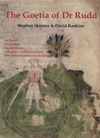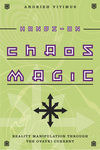Gods, Spirits, Servitors, and Pests: A Taxonomy of Spirits

We may be the only self-aware physical beings on Earth (although, I'm not certain octopi wouldn't give us a run for our money), but there are other places besides Earth. I'm not suggesting we discuss aliens, which may or may not exist and may or may not even visit Earth (although, I rather doubt it), but in a conversation on magic, it is crucial to discuss entities with non-physical bodies—beings composed of pure meaning, in other words, spirits. Spirits are collections of symbols with self-awareness. Some mages debate whether spirits exist separate from us, or merely as aspects of our psyche. I assert that they exist as aspects of our psyches, but so do our neighbors, parents, and friends. It's not productive to imagine spirits as being any less separate than the rest of the world in which we act. I have spoken with spirits who have told me things I did not want to hear. Spirits have also given me information I could not have otherwise known. They have lied and even broken promises. Spirits are real, whatever that means.
Taxonomy
Enough spirits are willing to interact with the mage to justify a system for classifying them. To this end, I've created a taxonomy—a system for the ordering and identifying of spirits. Many such systems exist, but most often they seem to exist for the express purpose of ranking spirits in a hierarchy. I tend to be suspicious of hierarchy, so my system of classification will not drawn upon any "chain of being." Nor does my system work like a scientific classification for animals, because there is no genetic relationship between spirits of different classes (as far as I can see). I will simply list types of spirits as I have perceived them. Qualities will be the means for identification.
Incidental Spirits
These types of spiritual beings are often called "astral garbage." I find this classification a bit aggressive. I prefer "incidental spirits." Their existence is incidental to your will (and, reciprocally, your existence is incidental to theirs). No one needs to call anyone "garbage." They usually want nothing to do with you. They don't care if you exist, and will happily ignore you even as you go about their business. They may be drawn to you out of curiosity, but will have no interest in talking to you once they find out you're human. They tend to cluster around large magical workings.
Inimical Spirits
These, on the other hand, are drawn to you for a specific purpose. They are angry—or just generally dislike humans—and therefore want to cause you pain. You can safely classify all "demons" and some hauntings in this category. I sometimes call these spirits shedim, a Hebrew word meaning "demon." I avoid the word "demon" because it carries religious connotations I often wish to avoid. When talking to Christians, however, I will sometimes use the term just to ease communication. Sometimes inimical spirits are guided by a human agency.
Amicable Spirits
These helping spirits usually carry the same power level as inimical spirits, but in the other direction. Here rest angels and most of the spirits (or "demons," according to some books, such as The Goetia and The Book of the Sacred Magic of Abramelin the Mage) you might wish to evoke. They tend to be fairly amoral, and will do what you like. Sometimes they request payment, but often they'll be happy to help for the fun of it. One person's amicable spirit can be another person's inimical spirit.
The elemental spirits are usually amicable, though some may be inimical and incidental. They are usually helpful in work consistent with their element. So an elemental of water would be useful in emotional matters, while and elemental of earth might be willing to help with prosperity magic.
Larvae
Singular, "larva." These are the pests of the spirit world. Physical and emotional traumas often attract larvae, just as wounds attract maggots. And, just like wounds, if one does not deal with the underlying problem, larvae will just come back again and again, even after being banished. Many people sense them feeding on the "energy" of those in pain, but I am uncertain about that explanation. It seems they could find easier sources of "energy." Perhaps they enjoy the sensation of strong emotions. Like inimical spirits, these creatures take multiple shapes, but tend to be much less powerful. The succubus and incubus (sexual spirits who provoke sexual dreams) could be considered a specialized and relatively harmless type of larvae.
Powers
These are the archangels of various systems. They are often friendly and helpful, but usually represent a single kind of power. So, while you'd rarely have a spirit of Mars, for example, you do have several Powers of Mars. They represent a pure type of elemental or planetary energy. They have a specific and relatively unvarying vector, a "will" (desire) perpetually focused on their sphere of influence. Spirits, as we have seen, are sometimes amoral—they act out of no moral code at all, and with no moral justifications. Powers are never amoral, but may be immoral—the Power of Hate, for example, is probably not pleasant. You can quite easily name a power after any abstract noun.
Nature Spirits
These are a kind of power (just as defined above), but are often more helpful. Frequently a person will attract one or more nature spirits as guides; hence, the animal guide craze of New Age "shamanism." One could consider these a subtype of powers—the Power of Eagle, for example. These are not the spirits of individual animals. The Power of Cat is not the same as the discarnate form of your pet house cat.
Discarnate Entities
Speaking of which, discarnate entities are beings who were once alive, but now are not. Some part of their personality often lives on in a state of greater or lesser awareness. Necromancy is concerned with calling up and dealing with these beings, which can range anywhere from your Uncle Phil to Boo-Boo, your pet poodle. They usually have no greater knowledge than they did in life. And it's not entirely clear, for example, if you call upon Uncle Phil that you will therefore get Uncle Phil. Masquerading as dead loved ones seems to be a favorite sport of some spirits, who can pick details out of your mind and weave them into a convincing fiction.
Gods
Unlike powers, gods have a full range of movement. Where a power is created from a single element or force, gods, like humans, are composed of multiple forces. Gods can act outside their spheres of influence, as is evident from a cursory glance at mythology, although they do not like to do so, and are often not very effective in so doing. Dealing with gods can be both dangerous and rewarding. They have their own agendas and goals, and their wills are much stronger than ours. Yet, they apparently need us to give them shape and form. It's a common occult opinion that gods who are not worshiped die. In my experience, this isn't even remotely true. I think our worship provides gods with form and structure, not with existence.
Otherworld Entities
Some beings, like dragons, are none of the above, but exist outside of our universe and visit it infrequently for arcane purposes. These are truly alien beings; sometimes they are not even spirits. Not much can be said of such beings, except they have their own purposes and little concern for humans. People who play with dragons may very well be playing with fire.
Multivalent Beings
Sometimes a discarnate entity and a spirit will join together, or a person's personality will be linked in some way to a power or to a god. These are complicated and fairly rare events. One example of a multivalent being is The Dalai Lama, who is both a mortal man and an incarnation of a power, the Bodhisattva of Compassion. One should not seek out such a joining. I have read and heard true horror stories of people seeking to become gods. Inevitably, such hubris leads to disaster.
Excerpted from Postmodern Magic, by Patrick Dunn
Related Products


is subject to certain Terms and Conditions